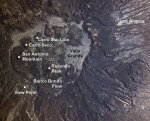- Joined
- Jul 19, 2012
- Messages
- 14,185
- Reaction score
- 8,768
- Location
- Houston
- Gender
- Male
- Political Leaning
- Libertarian
Yellowstone Park sits on the caldera of an enormous supervolcano capable of destroying much of the continental US if it erupts. It has done so several times through history, the last time 630,000 years ago, and it spreads a thick coat of hot ash over half of America every time it does erupt.
The caldera, which makes up much of Yellowstone Park's territory, is alive with volcanic activity, like hot springs and geysers scattered all over. Liquid magma sits a few miles below the surface, and the roof of the caldera has been bulging upward gradually for years in response to increasing pressure from below.
A recent 5.8 earthquake in Montana signals that a super-eruption is possible relatively soon, which is to say within the next few thousand years.
Natural Disaster: 5.8 Magnitude Earthquake Hits Montana, Raising Supervolcano Concerns
The caldera, which makes up much of Yellowstone Park's territory, is alive with volcanic activity, like hot springs and geysers scattered all over. Liquid magma sits a few miles below the surface, and the roof of the caldera has been bulging upward gradually for years in response to increasing pressure from below.
A recent 5.8 earthquake in Montana signals that a super-eruption is possible relatively soon, which is to say within the next few thousand years.
Natural Disaster: 5.8 Magnitude Earthquake Hits Montana, Raising Supervolcano Concerns

